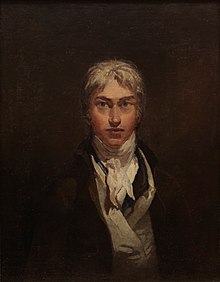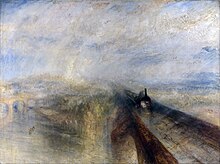
JOSEPH MALLORD (after his maternal uncle) WILLIAM TURNER
Born in London 23 April 1775. His father was a barber/wig maker., and sold his early paintings in his shop for a few shillings: He boasted that one day his son would become an artist.
Turner is a challenge to categorize because he was a water-colorist, an oil painter and a print-maker. He also sketched in a small book and painted from the graphite drawings in his studio. As he matured his work became increasingly impressionist and abstract, using techniques far ahead of his time.
Above all Turner is remembered for his stunning treatment of light. To Turner, light was the physical embodiment of God's spirit and so his later work shunned objectivity and concentrated on the play of light on water, the radiance of the sky and glow of flame. Although these late paintings appear 'impressionistic', Turner was striving to express spirituality rather than optical phenomena.
His distinctive style of painting, used watercolor technique with oil paint, creating lightness, fluency, and ephemeral atmospheric effects. In his later years he used oil even more transparently and turned to an evocation of almost pure light by the use of shimmering color. A prime example is Rain, Steam and Speed - The Great Western Railway, where objects are barely recognizable. The intensity of hue and interest in evanescent light, put Turner's work at the forefront of English painting and influenced the Impressionists, particularly Claude Monet, who carefully studied his techniques.
At 14 he studied at the Royal Academy of Art and developed a keen interest in architecture, but he was advised to focus on painting. At 15, A View of the Archbishop's Palace, Lambeth, his first serious water-color, was accepted into the Royal Academy summer exhibition and in 1796 the academy showed his first oil painting, Fishermen at Sea. In 1800 Turner preferred historical subjects, but moved on to the Romantic/Poetic genre.
Turner's major venture into printmaking was the Liber Studiorum (Book of Studies), seventy prints that he worked on from 1806 to 1819. Loosely based on Claude Lorrain's Liber Veritatis (Book of Truth), the plates were intended for wide distribution. This series categorized Landscapes into six types: Marine, Mountainous, Pastoral, Historical, Architectural, and Elevated or Epic Pastoral. Printmaking became a major part of Turner's work and in 1974, Douglass Montrose-Graem founded the Turner Museum in Sarasota, Florida focused on this aspect of Turner's work.
Throughout his life, Turner was a controversial figure. He never married, but he fathered children with one of his mistresses. Turner died in the house of Sophia Caroline Booth in Cheyne Walk in Chelsea on 19 December 1851. It is said his last words were "The sun is God".
(largely abridged from Wikepedia)

No comments:
Post a Comment
I love to hear your views and connect on a personal level so feel free to say hi.
All work by Sea Dean protected by International Copyright - No printing, copying, electronic transfer or any form of duplication allowed without written permission from the Artist.